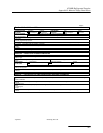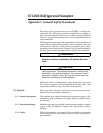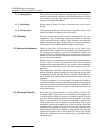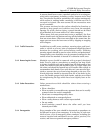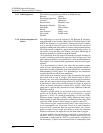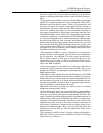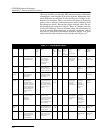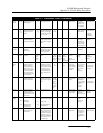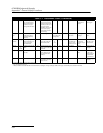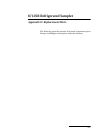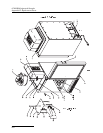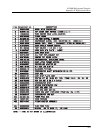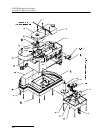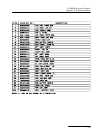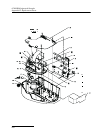
6712SR Refrigerated Sampler
Appendix C General Safety Procedures
C-7
Formal-
dehyde
CH
2
O Colorless, pungent suf-
focating odor.
1.07 Irritating to the nose. — 10 7.0 73.0 Near bottom. Incomplete
combustion of
organics. Com-
mon air pollut-
ant, fungicide.
Detectable odor.
Gasoline C
5
H
12
to
C
9
H
20
Volatile solvent.
Colorless. Odor notice-
able at 0.03%. Flam-
mable.
3.0
to
4.0
Anesthetic effects
when inhaled. Rapidly
fatal at 2.4%. Danger-
ous for short exposure
at 1.1 to 2.2%.
4,000
to
7,000
1,000 1.3 6.0 At bottom. Service stations,
garages, storage
tanks, houses.
1. Combustible
gas indicator.
2. Oxygen
deficiency
indicator.**
Hydrogen H
2
Simple asphyxiant.
Colorless, odorless,
tasteless. Flammable
0.07 Acts mechanically to
deprive tissues of oxy-
gen. Does not support
life.
— — 4.0 74.0 At top. Manufactured
gas, sludge
digestion tank
gas, electrolysis
of water. Rarely
from rock strata.
Combustible gas
indicator.
Hydrogen
Cyanide
HCN Faint odor of bitter
almonds.
Colorless gas
0.93 Slight symptoms
appear upon exposure
to 0.002% to 0.004%.
0.3% rapidly fatal.
— 10 6.0 40.0 Near top. Insecticide and
rodenticide.
Detector tube
Gas Chemical
Formula
Common
Properties
Specific
Gravity or
Vapor
Density
Air = 1
Physiological
Effect*
Max
Safe
60 Min.
Exposure
ppm
Max.
Safe
8 Hour
Exposure
ppm
Explosive
Range
(% by vol.
in air.)
Limits
lower/upper
Likely
Location
of
Highest
Concentration
Most
Common
Sources
Simplest and
Cheapest
Safe Method
of Testing
Hydro-
gen Sul-
fide
H
2
S Irritant and poisonous
volatile compound.
Rotten egg odor in
small concentrations.
Exposure for 2 to 15
min. at 0.01% impairs
sense of smell. Odor
not evident at high
concentrations. Color-
less. Flammable.
1.19 Impairs sense of smell,
rapidly as concentra-
tion increases. Death
in few minutes at 0.2%.
Exposure to 0.07 to
0.1% rapidly causes
acute poisoning. Para-
lyzes respiratory cen-
ter.
200
to
300
20 4.3
45.0
Near bottom,
but may be
above bottom
if air is heated
and highly
humid.
Coal gas, petro-
leum, sewer gas.
Fumes from
blasting under
some condi-
tions.
Sludge gas.
1. H
2
S Ampoule.
2. 5% by weight
lead acetate
solution.
Methane CH
4
Simple asphyxiant.
Colorless, odorless,
tasteless, flammable.
0.55 Acts mechanically to
deprive tissues of oxy-
gen. Does not support
life.
Probably
no limit,
provided
oxygen
per-
cent-age
is suffi-
cient for
life.
— 5.0 15.0 At top, increas-
ing to certain
depth.
Natural gas,
sludge gas, man-
ufactured gas,
sewer gas. Strata
of sedimentary
origin. In
swamps or
marshes.
1. Combustible
gas indicator
2. Oxygen defi-
ciency indicator.
Nitrogen N
2
Simple asphyxiant.
Colorless, tasteless.
Non-flammable. Prin-
cipal constituent of air.
(about 79%).
0.97 Physiologically inert. — — — — Near top, but
may be found
near bottom.
Sewer gas.
sludge gas. Also
issues from
some rock strata.
Oxygen
deficiency
indicator.
Nitrogen
Oxides
NO
N
2
O
NO
2
Colorless
Colorless,
sweet odor.
Reddish-brown.
Irritating odor.
Deadly poison
1.04
1.53
1.58
60 to 150 ppm cause
irritation and coughing.
Asphyxiant.
100 ppm dangerous.
200 ppm fatal.
50 10 — — Near bottom. Industrial
wastes.
Common air
pollutant.
NO
2
detector
tube.
Oxygen O
2
Colorless, odorless,
tasteless. Supports
combustion.
1.11 Normal air contains
20.8% of O
2
. Man can
tolerate down to 12%.
Minimum safe 8 hour
exposure, 14 to 16%.
Below 10%, dangerous
to life. Below 5 to 7%
probably fatal.
— — — — Variable at dif-
ferent levels.
Oxygen deple-
tion from poor
ventilation and
absorption, or
chemical con-
sumption of oxy-
gen.
Oxygen defi-
ciency indicator.
Table C-1 Hazardous Gases (Continued)



